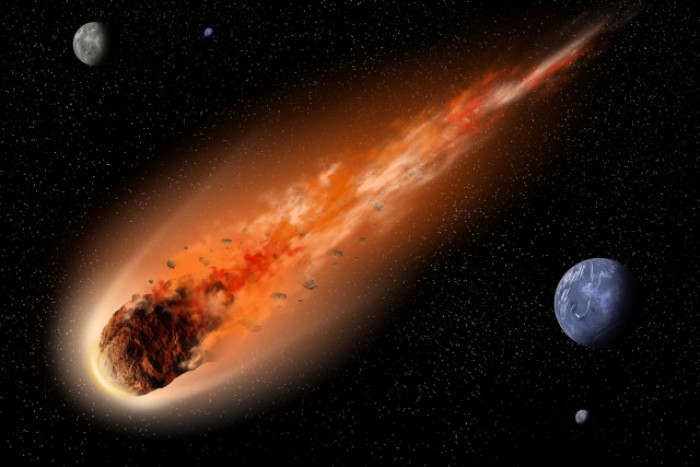

As a comet approaches the sun, the “dirty snowball” of the comet’s nucleus sheds gas and dust. Other meteoroids are the debris that comets shed as they travel through space. This can put the meteoroids on a collision course with a planet or moon. The force of the asteroid collision can throw the meteoroid debris-and sometimes the asteroids themselves-out of their regular orbit. As asteroids smash into each other, they produce crumbly debris-meteoroids. Many meteoroids are formed from the collision of asteroids, which orbit the sun between the paths of Mars and Jupiter in a region called the asteroid belt. The fastest meteoroids travel through the solar system at a speed of around 42 kilometers (26 miles) per second. Different meteoroids travel around the sun at different speeds and in different orbits.


Meteoroids are even found on the edge of the solar system, in regions called the Kuiper belt and the Oort cloud. They orbit the sun among the rocky inner planets, as well as the gas giants that make up the outer planets. Meteoroids, especially the tiny particles called micrometeoroids, are extremely common throughout the solar system. The Leonids are most apparent through the month of November, peaking around the middle of the month.Meteoroids are lumps of rock or iron that orbit the sun, just as planets, asteroids, and comets do. You may also hear of the Leonid meteor shower. Geminids is known for being the only large meteor shower that isn’t caused by a disintegrated comet it’s instead caused by a Palladian asteroid. Perseid meteor shower occurs around August time during the summer.Īnother great meteor shower that you should try to see is Geminids, which occurs in December. One of the most well known meteor showers is Perseids, which has a high rate of producing meteors and is usually one of the brighter ones. There are many different meteor showers that occur throughout the year. There are approximately 30 different meteor showers that occur at the same time each year.For example, Pi Puppids is located in the Puppis constellation. We name meteor showers based on the constellation which they appear in.Meteor showers have been noticed for thousands of years – the earliest writings we have recording them dates back more than 2000 years to the Chinese.We only have one known recording of a meteor hitting a person, all the way back in 1954.The name for a very bright meteor is a fireball, also referred to as a bolide.When a meteor makes it all the way to the Earth intact, we call the remains a meteorite.These storms can produce more than 1,000 meteors per hour. More intense meteor showers are known as meteor storms.A meteor is simply part of a meteoroid (a comet or asteroid) that has broken off from the meteoroid during it’s orbit around the Sun.The majority of meteor showers are caused by Earth moving through the remaining debris from disintegrated comets.When a meteoroid enters into the Earth’s atmosphere, they begin to burn up – this is when we call them a meteor.Let’s look at some facts about meteor showers. There are many different meteor showers that repeat throughout the year, so it’s definitely worth your time to try and see one. Though meteors are often seen on their own too – and then sometimes referred to as shooting stars – when grouped together and arriving at Earth in close succession, we refer to them as a shower. Meteor showers can be one of the best spectacles of the year, and if you haven’t seen one before, then you’re missing out.


 0 kommentar(er)
0 kommentar(er)
